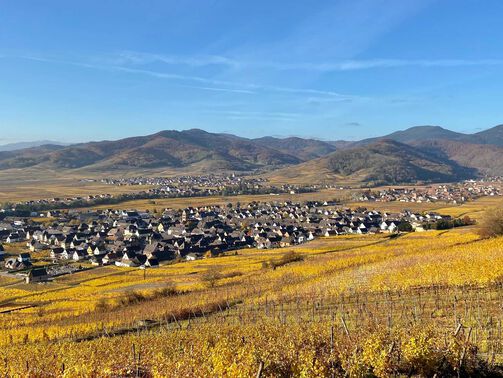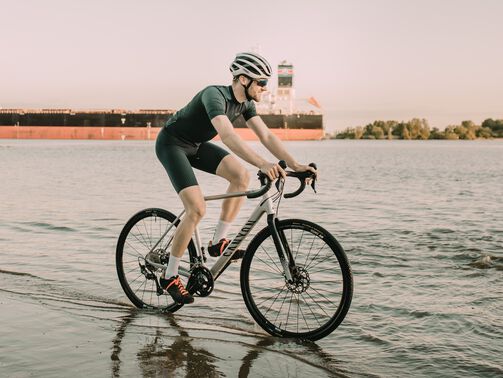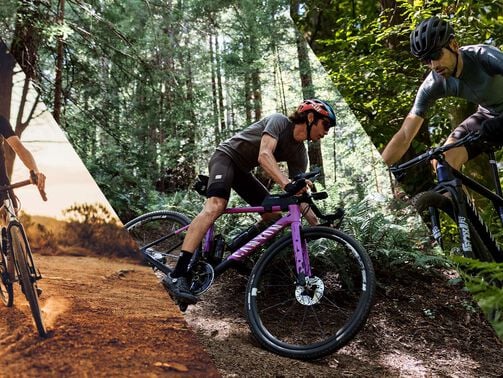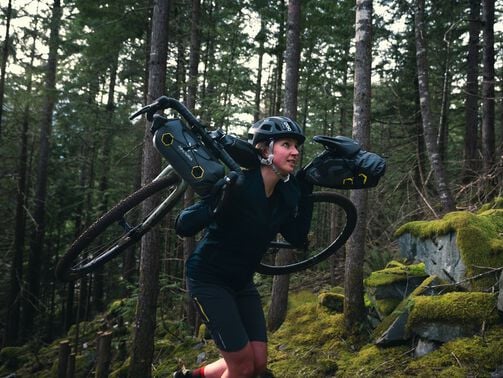Gravel groupsets explained: Everything you need to know
There are plenty of gravel bike drivetrains on the market, but which is the best gravel groupset for you? Learn everything you need to know from our guide to SRAM, Shimano and Campagnolo options.


Gravel bikes are versatile bikes that are ready for anything you throw at them. From riding through the city to week-long adventures in the wild, a gravel bike could be perfect for you.
For a while now, the major players in bike component production have all been making dedicated gravel bike groupsets , with specific performance factors that enhance your gravel riding. The drivetrain and all its related parts are an essential part of the riding experience, so it makes sense to modify for this specific style of cycling. Each rider has their preference, but there are a few key differences, advantages and disadvantages between each option. We take a look at the three most common gravel groupset manufacturers here.
Contents
What is a gravel groupset?
The word groupset refers to all the components on the bike that help to turn the pressure you apply on the pedals into forward motion, or bring you to a stop. That’s why the term ‘drivetrain’ is also sometimes used synonymously with ‘groupset’ – because it’s all the bits that drive you forward.
Breaking it down, a gravel groupset includes the following parts:
• Brake levers and gear shifters (often integrated together on a drop-bar gravel bike)
• Front and rear brake calipers
• Front and rear derailleurs (sometimes called front and rear mechs)
• Chainset consisting of chainring(s) and cranks
• Bottom bracket
• Chain
• Cassette (made up of 10, 11, 12 or 13 sprockets referred to as speed)
You can buy gravel bike groupsets separately if you're building up a frameset from scratch, however it's often more cost effective and easier to choose your groupset when you buy your bike.
Do gravel groupsets make a difference?
The choice of which will be the best gravel groupset generally comes down to personal preference and prior experience. Each manufacturer has a different setup when it comes to their gravel bike drivetrains. Even within each manufacturer's offering there are variations such as gear ratio and electronic versions.
Some groupsets use just one chainring (sometimes called “one by”, “1x” or “1by”) at the front, which means you’ll have 11, 12 or 13 gears. If you have two chainrings (written “two by” or “2x”), you’ll have 22 or 24 gears. 13-speed is currently only available for 1by. 1by groupsets have wide-ranging cassettes to make up for the lack of a second chainring. 2x groupsets have narrower cassettes where the jumps between sprockets are closer together.
If you ride your bike on predominantly flat terrain, you'll need fewer 'easy' gears compared to someone who tends to ride on technical, steep mountains.
A clutch derailleur is part of all gravel groupsets from Shimano, SRAM and Campagnolo . A clutch derailleur keeps the chain engaged with the chainset at all times. Expect less time off the bike putting your chain back on your chainrings and more time in the dusty trails ahead of you.
Let's take a look at the different gravel groupsets. We'll then answer some common questions which will help you decide which groupset is best for you and your gravel bike.

An overview of gravel groupsets
We’re going to look at the three biggest names in the gravel groupset game vying for the title of best gravel groupset: Shimano, SRAM and Campagnolo.
Each of these brands has a long history in cycling that goes back before the relatively recent gravel cycling boom, and each has manufactured road and mountain bike groupsets in the past. With the huge surge in popularity of gravel, it was only a matter of time before they each released their own gravel bike groupset – and they all have something slightly different to offer the off-road, drop-bar bicyclist. Let’s take a look!
Shimano gravel groupsets
Shimano is one of the best-known cycling component manufacturers. The Japanese company is a global household name and is synonymous with performance, quality and reliability.
Shimano's dedicated gravel groupset, GRX, is one of the most popular choices on the market. It differs from their range of road groupsets to cater for different gear ratios and features unique to gravel cycling. You'll find GRX options on our Grizl and Grail gravel bikes.
Take a look at the available GRX groupsets and some of their strengths and weaknesses.
| Pros | Cons | |
|---|---|---|
| RX400 | Entry-level groupset with an accessible price tag to match. | Limited to just 10-speed cassettes giving a narrower range of gears. |
| 2x crankset with 46/30T chainrings creates a decent range of gears to choose from, partly compensating for the small cassette. | Heavier than the more premium options in the GRX family. | |
| Not available with electronic Di2 shifting. | ||
| RX600 | RX600 A very good mid-level groupset, equivalent to Shimano’s 105 groupset for road bikes. Not high-end enough for really exacting riders or those who want to race gravel competitively. | RX600 A very good mid-level groupset, equivalent to Shimano’s 105 groupset for road bikes. Not high-end enough for really exacting riders or those who want to race gravel competitively. |
| Single and double chainring configurations (1x11 or 2x11). The 2x setup comes with 30-46T chainrings and either an 11-32 or 11-34 rear cassette. Sits in a tricky middle ground between the top performance of RX800 and the accessibly priced RX400. | Single and double chainring configurations (1x11 or 2x11). The 2x setup comes with 30-46T chainrings and either an 11-32 or 11-34 rear cassette. Sits in a tricky middle ground between the top performance of RX800 and the accessibly priced RX400. | |
| Not available with electronic Di2 shifting. | ||
| RX800 | RX800 The pinnacle of Shimano’s gravel performance pyramid, equivalent to Ultegra on road bikes. As a high-end groupset, the RX800 will cost you a lot more than the budget-friendly RX400. | RX800 The pinnacle of Shimano’s gravel performance pyramid, equivalent to Ultegra on road bikes. As a high-end groupset, the RX800 will cost you a lot more than the budget-friendly RX400. |
| New RX820 is electronic Di2 and uses a wireless cockpit. The slightly older RX815 is also electronic. Some reviews noted the ‘bulky’ look of the shifters, which can upset the sleek, svelte look of your bike – particularly on smaller frames. | New RX820 is electronic Di2 and uses a wireless cockpit. The slightly older RX815 is also electronic. Some reviews noted the ‘bulky’ look of the shifters, which can upset the sleek, svelte look of your bike – particularly on smaller frames. | |
| Crisp and reliable shifting, lightweight components and advanced features. 140mm rear brake rotor can struggle on longer descents when a bike is loaded for bikepacking. | Crisp and reliable shifting, lightweight components and advanced features. 140mm rear brake rotor can struggle on longer descents when a bike is loaded for bikepacking. | |
| Servo Wave enables non-linear braking meaning the pads immediately engage when the brake lever is pulled, but afterwards it’s a more gradual pressure. |
Shimano is updating its GRX family of products all the time, most recently with the launch of RX820, which pushes the electronic functionality of the groupset even further than the pre-existing RX815. It’s worth saying if you’re unfamiliar with how Shimano names its products that the first digit after the RX – in our case, either 4, 6 or 8 – indicates the ‘tier’ of the product. Then as the following numbers increase – 15, 20 – you move through the generations and start to see more advanced functionality. They may not make for the catchiest product names, but they do at least have a solid internal logic.
Shimano’s ubiquity in bike shops around the world makes them a great choice for your next gravel bike, as you stand a good chance of being able to find spare parts should you need them in the middle of a gravel bikepacking adventure.
Our all-road bikes like the Endurace are specced with Shimano's well-known road groupsets.
SRAM gravel groupsets
SRAM were early adopters of the dedicated gravel bike drivetrain. They launched their Force 1 groupset, targeted at gravel riders and cyclocross racers, way back in 2015, some four years before Shimano GRX was released. This has given SRAM a great standing in the gravel cycling world, particularly as a US-based brand with deep roots in the American gravel racing scene, which has come to dominate worldwide thanks to races like Unbound and Belgian Waffle Ride.
SRAM makes four groupsets for gravel bikes, which we’ll look at in more detail below. It’s important to remember that some of these names reoccur elsewhere in the SRAM product line – the indicator that a SRAM product is specifically made for gravel is the suffix XPLR.
| Pros | Cons | |
|---|---|---|
| Apex XPLR | The most budget-friendly SRAM groupset for gravel riding. | 1x setup may feel limiting for some riders. |
| Available with AXS wireless shifting and cross-compatibility, a revolutionary offer on an entry-level groupset. | Not the best for very technical climbing or super-steep inclines. | |
| Reliability and low maintenance of a 1x setup. | While it’s the entry-level for SRAM it is markedly more expensive than Shimano’s most accessible gravel groupset. | |
| Rival XPLR | Benefits from AXS wireless setup and customisability features. | Only compatible with one cassette in the XPLR range, 10-44T. Although it can be used with some non-gravel SRAM cassettes too. |
| Excellent shifting and chain security. | Heavier than SRAM’s Force and Red options so if you’re really looking to optimise weight then you may want to look higher up the pecking order. | |
| Reliability and low maintenance of a 1x setup. | Pricier than the mechanical RX600 offered by Shimano. | |
| Force XPLR | More premium and polished finish takes it up a notch aesthetically when compared to lower-priced SRAM gravel groupsets. | 1x setup may feel limiting for some riders. |
| Small material upgrades like the use of carbon fibre on the crank arms level up performance and reduces weight vs Rival. | Doesn’t add a huge amount of extra functionality for the increased cost, and remains heavier than the top-tier Red XPLR. | |
| Reliability and low maintenance of a 1x setup. | ||
| Red XPLR | The elite tier delivers amazing performance for riders for whom price is not a problem. | Comes with a hefty price tag, although worth it for the level of functionality and aesthetic polish. |
| Uses even more advanced materials, such as titanium hardware, to ensure long-lasting durability and reliability, even on the rowdiest gravel tracks. | ||
| Amazingly light, giving you all the responsiveness you want on the trail. |
Perhaps by virtue of their longstanding position in the gravel groupset world, SRAM’s offer is the deepest you’ll find, with four different and impressive products to pick from. The fact that all their groupset options come with AXS wireless tech as an option is genuinely remarkable, and could tempt even some of the most diehard mechanical shifting adherents to make the switch to cable-free transmission.
While we haven’t covered it here in the table, SRAM does actually offer a 2x gravel setup – albeit this is far from the brand’s main focus.
As well as bikes with SRAM’s gravel-dedicated groupsets, we also offer one model with whats known as a mullet drivetrain. This is where a MTB cassette with a wide range is paired to a set of drop bar shifters. It’s unconventional, but increasingly common – and we’ll be bringing out more mullet setups through 2025.
If you think the extra-wide range of an MTB cassette is right for you, check out the SRAM Eagle-equipped Grizl CF SL8 and keep an eye on the website for more mullet drivetrain gravel bikes coming up.
Campagnolo gravel groupsets
Campagnolo is the newest player of the Big Three to enter the world of gravel. The Italian company has a reputation for high quality. If you're a cycling aficionado with a taste for lightweight, beautifully crafted components, Campagnolo might be on your wishlist.
Unlike the other manufacturers, Campagnolo currently only offers one gravel groupset: Ekar. It was the world's first 13-speed mechanical groupset when launched and it's also the lightest of all the groupsets (although Red XPLR gives it a run for its money). Let’s check out some of the pros and cons.
For Ekar, Campagnolo have retained the unique design of their ergonomic levers and thumb shifters. The curved shape of the levers make it easy to brake safely and quickly when required. When you ride in the drops, you'll feel in control.
| Pros | Cons | |
|---|---|---|
| Ekar | One of if not the lightest gravel bike drivetrains available on the market today. | Campagnolo componentry is comparatively expensive and Ekar is pitched firmly at the upper end of the gravel bike groupset market. |
| 13-speed cassette with 1x setup gives you a huge range of gears to play with. | No electronic option. | |
| Italian craftsmanship and long heritage of prestige. |
Canyon gravel bikes specced with Campagnolo come with a 40T single chainring, though you can swap this for 38, 42 or 44 tooth chainrings if you decide you need easier or harder gears further down the line. Three cassette options are available: 9-36, 9-42 and 10-44. We've put the 10-44 cassette on our Grizl.

How to choose the right gravel groupset
Now that you understand the different options available, how do you figure out which one is the best gravel groupset for you?
You’ll have to consider the terrain you’ll most often be riding on, as well as the way you want to ride it (fast, competitive and aggressive, or party pace only?). And then of course there’s the question of whether 1x is the right solution for you. Road cyclists sometimes struggle with the concept of stripping everything back to just a rear derailleur, but the benefits to 1x are huge and there’s a good reason it is the dominant mode in gravel cycling.
1x or 2x for your gravel groupset?
1x and 2x refer to the number of chainrings on the bike. On gravel groupsets, there is either one or two chainrings at the front. If you have two chainrings, there will also be a front derailleur on the bike in order to switch between them.
Gravel gearing bridges between road bike and mountain bike gearing. Mountain bikes almost always have 1x gearing whereas road bikes are rarely seen without two chainrings. There are scenarios for both in the gravel world.
Choosing 1x or 2x is only half the story. Gearing is of course made up of both the chainrings and the cassette. An all-road bike will likely have a more road-focussed gear ratio made up of two chainrings. Other gravel bikes may be veering into mountain bike territory and their gearing will reflect this.
The simplicity of a 1x groupset is very attractive to a lot of riders. Whether you're racing at the likes of Unbound and don't want the risk of a mechanical or you're on a technical climb and haven't got the mental fortitude to fiddle with front and rear mech combinations, a single chainring is a good solution.
A 2x setup on the other hand will have more options when trying to find the perfect gear for the scenario you find yourself in. Smaller increments in the sprockets on the cassette mean you can really tune your gears to the pace you need to ride.
Is gravel gearing easier?
Gravel gearing is easier than road bike gearing. Gravel riding often overlaps with bikepacking which means you'll be carrying a lot more weight on your bike. You'll appreciate easier gears when you've packed your bikepacking bags with everything on your kit list. Even if you're not doing a bikepacking overnighter, you might find that you carry more water, food and gear due to the remote nature of gravel rides.
Climbing on loose terrain often means traction is a challenge. You'll find yourself climbing in the saddle a lot more frequently in order to give the rear tyre more weight and grip. This means you won't have that explosive power when you're out of the saddle.
Mechanical or electronic shifting for gravel bikes?
Mechanical shifting is a very organic experience. Move the lever, it pulls the cable and changes the gear. It works and it's (usually) easily fixed when it doesn't. However, the invention of electronic shifting has changed the game.
You can get mechanical shifting on three different Canyon gravel bike models. If you prioritise speed on well-made gravel roads then the Grail CF SL 8 is going to be your best option, with mechanical Shimano GRX RX820 shifting also available on the Grail CF SL 7.
If your tastes run to the rowdier side of things, then the Grizl is going to fit the bill. This specification of the Grizl CF SL 8 uses Campagnolo’s mechanical-only Ekar 13-speed groupset, while you can also find Shimano GRX mechanical drivetrains on the Grizl 6 and Grizl 7. Finally there’s the Grizl:ONfly CF 7 and Grizl:ONfly CF Daily, two amazingly capable gravel e-bikes.
Electronic shifting sends an electrical signal to the derailleur either wirelessly or through a cable. You don't need to worry about wear and tear on the cables since they're never under stress. On long-distance rides or in particularly cold conditions, electronic shifting really comes into its own. A simple push of a button instead of wrangling a lever can make a big difference to your comfort and enjoyment.
Batteries on electronic groupsets last for months and in the case of SRAM you can even pack some spares.
The downside is the price, of course. Electronic gravel groupsets are more expensive both at the point of purchase and for replacement parts. It's still possible to break your derailleur and replacing it will be more expensive than its mechanical counterpart. For this reason, you may wish to pursue mechanical shifting to avoid worrying about the bill at the end of a particularly unlucky ride.
When it comes to Canyon bikes with electronic gravel bike groupsets, this makes up the majority of the models you’ll find on our website. With the very latest Shimano GRX Di2 represented on the Grail CF SLX 8 Di2 and SRAM’s elite Red XPLR AXS gravel groupset featuring on our Grail CFR XPLR. At the entry-level end of the selection, the Grizl CF SL 6 AXS offers the impressive performance of SRAM Apex XPLR AXS.

How to choose: What is the best gravel groupset for you?
There are no right and wrong answers when it comes to choosing the best gravel groupset. If you have experience with a particular brand, you may wish to stick to them for ease and familiarity. Some people find the Campagnolo switching levers totally alien, while long time adherents of the brand wouldn’t dream of riding anything else.
The most important thing to do is to figure out your budget and non-negotiable features and the rest will follow. If you race regularly or you want to race then look for a cassette with a wide range of gears for maintaining speed and readily available parts for servicing. If you favour adventure capability, then a small crankset and the capability to run a very large sprocket on the cassette is going to help a lot – particularly if the bike is loaded.
Remember that buying a gravel bike groupset as part of a bike is the cheapest way to get access to the top tech – and that buying a groupset on its own will always involve paying a premium. That being said, don’t buy a gravel bike with a drivetrain of such high quality that you then can’t afford to replace the parts as they wear out.
Discover our Gravel Bikes
Did this article help?
Thank you for your feedback








